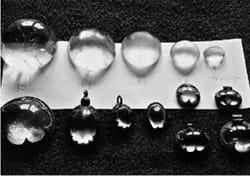(PCM) The Visby Lenses were found on the Swedish island province of Gotland

Several lens-shaped pieces of quartz of varying size found in a Viking grave, dating back to the 10th century. Some are mounted in silver. Today, the lenses can be seen at Fornsal historical museum in Visby and the Swedish National Museum in Stockholm, both in Sweden.
Mystery:
The function of the lenses is unclear, and they possess technology highly sophisticated for the 10th century. The mounted lenses appear to have been used as jewelry, but the others may have been used for different purposes. The surface of the lenses have a near-perfect elliptical shape, giving them optical qualities comparable to those made in the 20th century, many years before we were smart enough to even describe the shape and properties of such lenses. Also, the rock crystal used to make the lenses is not native to the area. Some theories are that they may have been used to magnify smaller things for fine work or for reading, to start fires, or even for trade.
The Visby lenses are similar to, but crafted in a much more detailed way than the Nimrud Lens, a natural rock crystal, found in modern day Iraq, crudely ground as an early magnifying glass about 3000 years ago. The lenses we know today were created mathematically 500 years later, by Descartes, who was also the Founding Father of what we now call calculus.
The Unanswered Question:
Where did they come from?
Because the imaging of the lenses is so good, the suspicion is that they may have been used for some sort of telescope, but over 500 years before the first known telescopes were invented. The Vikings were not known for this kind of detailed technology, and the theory is that they were collected in trade, although we don’t know who they could have with to get them. That kind of technology in lens-crafting simply didn’t exist at that time, but the raw crystals came from the Byzantine Empire.
The post Visby Lenses Date Back 1,000 Years appeared first on Weird But True News.